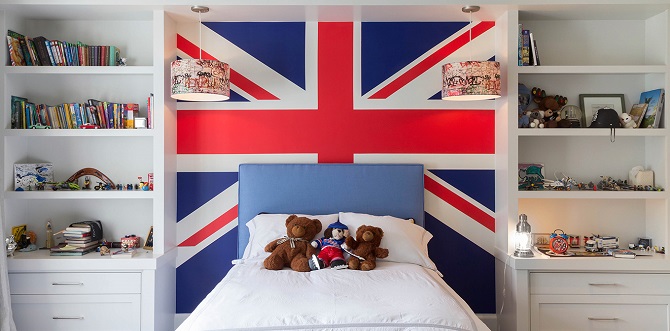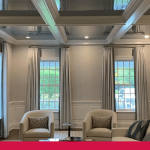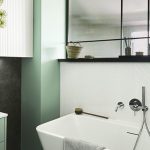How to Choose an Accent Wall & Color
May 4, 2024

What do you notice when you first walk into a room? Is there a specific feature that draws your attention? Perhaps an item in the room is a contrasting color that really stands out from the rest of the surroundings. This is the purpose of using an accent wall in your interior house design.
Adding an accent wall to your favorite room is a great way to give your home’s design a lift without spending too much on new décor. But before buying new paint, it’s best to understand how to choose the best accent wall location and colors.
Tips for Choosing the Right Accent Wall
Not every wall in a room is the best choice for an accent wall — a good accent wall rule of thumb is choosing a wall that your eye is naturally drawn to. Walls with architectural elements or where a prominent piece of furniture is displayed are ideal as accent walls so you can highlight those design features.
Accent walls are ideally solid and not broken up with windows or doors. While it may seem like a great idea to highlight beautiful doors or a great view, the accent wall will actually distract from those elements. And by placing an accent color on a wall with a window, you’ll actually find the light darkens the color and room during the day. If you’ve got a long, awkwardly shaped room, accent walls are a great solution to make the room seem less oblong — try painting the short wall at the end of the room to make the space seem smaller and more connected.
Understanding Color Basics
Now that you’ve chosen the perfect accent wall to paint, which color is best for the space? If you’re unsure if you want a different color than the existing walls, a subtle accent wall solution is choosing a paint color two shades darker than what you currently have. If you’re looking for a bolder pop of color, then understanding color basics will ensure you maintain harmony in your space. There are three color schemes to consider when painting — monochromatic, analogous and complementary.
Monochromatic: This scheme uses shades of the same color, which will create a lively and simply elegant design. Monochromatic colors create a visually interesting and coherent style.
Analogous: These colors are next to each other on the color wheel, like green and blue or orange and red. Like monochromatic schemes, analogous choices are a simple but add a bit more dynamism in the room by creating a focal pop.
Complementary: The most bold of the schemes, complementary colors are opposite each other on the color wheel — purple and yellow, red and green and blue and orange. These color combinations are energetic, and the most successful method to incorporate these contrasting colors is to pair warm and cool tones.
By keeping these color combinations in mind, you can successfully choose a color for your accent wall that compliments your existing furnishings and décor.
Best Accent Wall Colors
Consider your room’s purpose before selecting a color — do you want to feel relaxed or have a lively space that stimulates thought or conversation? Browns, greens and neutrals are great for a relaxing and natural-feeling space, while bold colors like reds and yellows will insert a burst of energy in the room.
Another detail to consider before painting is how this wall will easily incorporate and create harmony throughout the other spaces in your home. There are seven colors in the paint spectrum, and most colors are composed using the other colors. An easy way to connect rooms is by carrying elements from one room to the next — choose a color blended with several colors you’ve already incorporated as an easy solution to achieve flow.
Don’t Pick a Random Color
Homeowners without the right experience in using accent walls often don’t understand the premise behind this effect. You won’t be happy with the end result if you simply choose your favorite color or select one at random. Instead, it is important to use other elements in the room, including the color of the rest of the walls, to make the right decision.
Complement the Other Walls
The color of your accent wall should complement the color of the other three walls in the room. Unless the color your painting contractor uses in the rest of the room is a neutral color, such as a white or off-white, you need to make sure your accent wall color blends well. Choosing a color from the same palate as the main color will ensure the two look great together.
Look Around the Room
In addition to choosing a complementary color, painters often use a color pulled from other elements in the room. For instance, do you use decorative pillows or colorful accent pieces and furniture? Perhaps you have a favorite painting hanging in the room. Drawing a color from the décor can tie your accent wall into the rest of the room. If you aren’t sure which color is the right choice, talk to your painting contractor. They have the necessary experience to help you make this important decision.
One of the biggest trends painters are using today is accent walls in bedrooms, dining rooms, kitchens and living rooms. In addition to choosing the right wall to accent, it is also important to choose the right color. Working with an experienced painting contractor ensures you achieve the desired effect when your project is complete.
A Bold Move in a Neutral Room
In many cases, individuals choose neutral colors for three walls in the room and contrast it with a bold color for the fourth wall. This bold hue can draw attention to an area of the room that may otherwise be unnoticed. The most important thing to remember is not to create too many focal points in one space. Other competing focal points can include plants, a sculpture or even framed pictures.
If you ask your painting company to implement an accent wall into your interior house painting, understanding the basics of this tactic will help you create a more interesting room. This technique can be used in just about any space in the home, drawing attention to one area over the rest.
Why Trust a Professional Painter?
Why should you hire a professional painter when you can buy paint at your local hardware store? By hiring a professional, you’ll experience the following perks:
- Expertise
- Professional tools and equipment
- Presentation — no streaks or drips
- Time-saving
Spruce up Your Home With Shoreline Painting
If you’re in the Fairfield County, CT area and looking to update your space, trust the experts at Shoreline Painting. We offer free project estimates and are proudly a Fine Paints of Europe Master Certified Painter. Contact us to schedule a consultation or give us a call today at 203-302-1086.
Recent Posts & Guides








